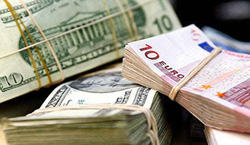INDOCHINA INTERNATIONAL CONSULTING CO., LTD
HO Add: 62L/36 Nguyên Hồng, Ward 11, Bình Thạnh District, HCMC - Vietnam
Biz Office Add: #48 Road No 11, Quarter 6, Hiệp Binh Chánh Ward, Thủ Đức, HCMC - Vietnam
®Source: http://viipip.com should be clearly quoted for any use of information extracted from our website.
Publication permit No: 60/GP-TTĐT , April 05, 2010.


A year of ups and downs
The VND/US$ exchange rate dropped dramatically in Q1 2008 with the rate at one time falling to VND15,960/US$1 on the interbank market and to VND15,700/US$1 on the black market. But it then surged dramatically in Q2, hitting the highest
The State Bank of Vietnam had to intervene to force the exchange rate down to VND16,400/US$1, which remained the dominate rate until the end of Q3.
However, since September, the exchange rate has, once again, been increasing, with the rate as high as VND16,998/US$1. Despite efforts by the central bank to intervene, the exchange rate has been staying firmly high at VND16,985/US$1. Meanwhile, on the black market, the threshold of VND17,000/US$1 has been broken.
Explaining the fluctuations of the foreign currency market, Nguyen Manh, Capital Source Director of the Bank for Investment and Development of Vietnam (BIDV), said that in Q1, the exchange rate decreased because of the big volume of overseas remittance from the end of 2007 to February 2008, and foreign investors’ purchases of government bonds (worth $1.4bil). Moreover, it was also because a lot of export companies borrowed money in US$ because of low interest rates, and then converted the money into VND for production and business.
However, the conditions were quite different in Q2 with the big trade deficit ($7.22bil in April-June), the big demand of import and export companies for foreign currencies to pay debts, and the increase of gold imports triggered by the big gap between domestic and international prices.
After that, foreign investors began withdrawing capital from
At that time, the demand of foreign banks for dollars was relatively high - an estimated $40mil a day.
In addition, the demand for dollars increased sharply because of concerns about the exchange rate. People began to purchase dollars with their savings.
Meanwhile, the trade deficit began increasing again: In October and November it climbed to $1.17bil.
Three scenarios for VND/US$ exchange rate in 2009
It has been asked if the fluctuations of the VND/US$ exchange rate will continue in 2009.
On December 8, 2008, BIDV’s research team released a report with three possible scenarios for 2009.
Scenario 2: the payment balance is minus $7bil, due to the trade deficit of $21bil, the outflow of FPI $1.5bil, while the capital balance is plus $15.5bil (FDI: $10bil, overseas remittance $4bil and ODA $1.5bil).
Scenario 3: the payment balance is minus $9bil due to the trade deficit of $23bil, the outflow of $1.5bil in FPI, while the capital balance is plus $15.5bil.
According to Tran Phuong, Investment Director of BIDV, a member of the analysis team, scenario 2 is the most likely. If this happens, in 2009, the VND will devalue by 3.5-5% against the dollar, while the VND/US$ exchange rate will increase step by step before reaching the highest peak of VND18,000-18,200/US$1 by the end of Q2 in 2009 and decreasing gradually towards the end of the year to VND17,600-17,800/US$1.
- FDI capital continues to pour into Vietnam (6/11/2025 1:20:33 PM)
- Thanh Hoa receives good news: Preparing to have an additional industrial park of up to 470 hectares, creating jobs for nearly 30,000 people (6/11/2025 1:15:09 PM)
- Industrial Park Real Estate: Waiting for the New Generation of FDI (6/11/2025 1:10:15 PM)
- A wealthy Vietnamese city will have two special economic zones after the merger (6/11/2025 1:04:42 PM)
- 30 billion USD capital FDI in Việt Nam by 2025, a series of "ông big" races to expand the land fund (6/11/2025 12:55:26 PM)
- the 2nd largest city in the North will start construction on an international economic zone (6/11/2025 12:50:20 PM)
- Japanese giant Sumitomo continues to want to build an industrial park in the countrys fourth smallest province. (6/11/2025 12:40:45 PM)
- 3 foreign corporations want to invest billions of dollars in Ba Ria - Vung Tau (6/11/2025 12:34:30 PM)
- Lotte Group member starts construction of nearly 1,000 billion VND logistics center in the province with the most industrial parks in Vietnam (6/11/2025 12:33:26 PM)
- Forming a regional center for manufacturing spare parts and components (6/11/2025 12:24:08 PM)
- Vietnams first wafer factory is about to start construction (6/11/2025 12:19:09 PM)
- Dong Nai attracts foreign investors (6/11/2025 12:13:27 PM)
- Tay Ninhs largest industrial park welcomes a $150 million high-end knitted fabric factory project (6/11/2025 12:11:00 PM)
- (6/11/2025 12:09:10 PM)
- Vietnam will become a destination for Chinese investors in the future (11/6/2023 1:03:19 PM)

- FDI capital continues to pour into Vietnam
- Thanh Hoa receives good news: Preparing to have an additional industrial park of up to 470 hectares, creating jobs for nearly 30,000 people
- Industrial Park Real Estate: Waiting for the New Generation of FDI
- A wealthy Vietnamese city will have two special economic zones after the merger
- 30 billion USD capital FDI in Việt Nam by 2025, a series of "ông big" races to expand the land fund










 ADB: Vietnam’s 2009 GDP growth to be highest in South East Asia
ADB: Vietnam’s 2009 GDP growth to be highest in South East Asia MGM Grand Ho Tram: Vietnam’s First ‘Las Vegas Style’ Integrated Resort
MGM Grand Ho Tram: Vietnam’s First ‘Las Vegas Style’ Integrated Resort Nha Trang’s Twin Towers project licenced
Nha Trang’s Twin Towers project licenced Foreign investors still have good opportunities in Vietnam
Foreign investors still have good opportunities in Vietnam Sierra Wireless gets a foot in Vietnam’s ICT market
Sierra Wireless gets a foot in Vietnam’s ICT market